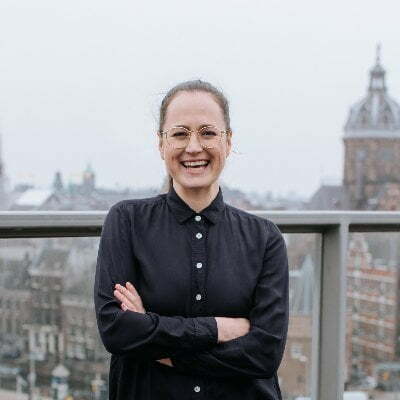With startups from Amsterdam raising a record-breaking 3.8Bin funding this year so far, it is good to realise that funding does not equal success. In fact, many startups can realise growth by largely funding their own operation. And there are perks to that approach. Amsterdam-based startups Settly, Referral Factory and SwapBox chose to bootstrap their way to the top, and they are still going strong.
Settly: conscious choice to bootstrap
Get to know the amazing finalists here
“I would be lying if there have not been times where it would have been nice to just be able to spend large sums of money without blinking an eye”, says Marieke van Iperen, CEO and co-founder of Settly, about not looking for investor’s money. “Especially when it comes to talent or expanding our product development to offer more services. Being a business owner you constantly see opportunities and areas of growth and not having a big bag of money means you can’t do it all.”
Settly specialises in finding and retaining international talent for companies. When founding her HR-tech startup in 2019, she made the choice to bootstrap the operation. Before founding her own startup, Van Iperen says she worked in a hyper-growth environment, where growth was the most important metric. “With Settly we wanted to create a business that had the customer and employee experience at the core of its value proposition instead of growth. For us, it meant that we wanted to make decisions that follow these principles.”
Confidence of product-market fit
From the start, Van Iperen did have the luxury of having some capital and a developing lead that allowed them to build the MVP themselves. “Our very first clients also wanted to go live with us before we had actually finished the product. That first proof of product-market fit gave us the confidence that we had built something that could actually make a difference. Despite the pandemic more clients quickly followed.”
“Especially in the very early stages of our business, we felt that going down the VC road would take away time and focus from building out our business, and could potentially mean that we would have to compromise on values and priorities. We’re ambitious in our goals, but we are also strong believers in creating a value and purpose-driven business. Sometimes that means that you make decisions that can impact your speed of growth but allow you to stay close to what you believe in.”
Settly currently operates in 4 countries and expects to launch in 6 new countries in the coming year. The team size of 18 is expected to have doubled by the end of the coming year.
Referral Factory: operating in 20 countries
Another rapidly growing startup from Amsterdam is Referral Factory. Their software allows any business to set up a referral programme to recruit new customers, without needing any technical knowledge. “We currently have active customers in over 20 countries, with the UK and USA being our largest markets”, says founder Kirsty Sharman.
“Our team is still small, we’re six people now and will be nine in January – our product is largely self-serve so the core team has been product and support until now, with marketers coming soon to help us accelerate our growth in 2022.”
Relying on revenue
Sharman relied on revenue to grow the company in its initial stage. At first, they served as a consulting company, building custom referral programs for corporate clients. This allowed them to build their software platform. Sharman: “Since then the SaaS revenue from the platform has been increasing monthly so we’ve been able to slow down the consulting work.” That homegrown referral platform also came in handy for the company itself, as Sharman used it to build the customer base without having any marketing budget.
The choice for bootstrapping meant Sharman had to work hard to get the company up and running. But she is convinced it pays off in the long run. “You pay the price today by working 16 hour days, seven days a week to get your business off the ground, but you reap the rewards tomorrow when you retain all the equity in your startup for longer. This is important because it means that by the time you do decide to raise capital, you’ll get a higher valuation and be able to retain more of your company. If you end up raising a series A, and series B, then you’ll be incredibly grateful to your younger self for holding on to as much of your company as possible early on.”
‘Ruthless with budget’
“Something that bootstrapping taught me is to be ruthless with my time and budget. Because you have to survive without any capital you think very carefully about every cent spent. I think in your early days that is a good thing. It forces you to talk to every customer, and really care that they get results and not just that they pay a subscription. This attitude isn’t scalable, and at some point, you’ll need to move faster or fear being eaten by the competition. But the first few months at Referral Factory, where we had no money in the bank and big dreams, drove some of the best problem solving within the team.”
She does add, this mindset is product and industry dependent. “We’re in adtech, so we didn’t have any expensive licenses to acquire as you do in fintech, or any expensive processes to follow as you do in biotech. So we were able to fund the initial growth and team costs by bootstrapping.”
Swapbox: bootstrapping with a physical product
That’s something Maurits Last experienced. He is co-founder of SwapBox, a sustainable alternative to single-use packaging for takeaway food. Registered users can request a SwapBox at participating restaurants for free to receive their order in a sleek, reusable bowl. Despite dealing with a physical product, which requires operational efforts to maintain, Last got his company off the ground without any outside funding.
“Part of it was a conscious choice”, he explains. “I wanted to give away as little of the company as possible. On the other hand, the concept was new, which made it harder to convince investors. So we decided to bootstrap. Looking back though, we did make some choices that don’t really fit in with the method of bootstrapping.”
Buying equipment
As an example, Last mentions the investments they had to make in obtaining equipment to run their business like a cargo bike and a dishwasher. Their initial idea was to pick up the dirty SwapBoxes from restaurants for cleaning. But restaurants already have their own dishwashers and were happy to clean their own SwapBoxes.
“As a bootstrapper, you ideally want to build an MVP for as little as possible and work from there. So in a sense, we didn’t follow the bootstrapping philosophy.” The investments Last did were not in vain. They did open other opportunities. “We have some large catering partners as customers now. They appreciate the fact that we do the cleaning for them.”
More clients than expected
The fact that Last started out with little cash, did not hamper his growth, he says. “We were growing very fast in the beginning. We had more clients than we expected, although they used less than we had hoped. At some point, we wanted to turn our original web app into a real app. That’s when we got stuck. Luckily we could merge with a similar company, WePack, last February. Their buy-in brought us some money and allowed us to develop an app.”
In the first year of its existence, SwapBox grew from 0 to 80 customers. They have 4,000 users at restaurants and corporate caterers that use SwapBox to provide zero-waste lunches at companies like Bain & Company, LinkedIn and Vermaat. Recently, Last says he did raise a seed-funding of 500K, on top of a loan of a similar amount, providing the company with some runway.
Raising funding after bootstrapping
After bootstrapping the start of her company, Sharman says she also raised funding. “We just sold 6 per cent of the company to raise 300,000 euro. We bootstrapped until we had over 100 paying customers, and then raised the seed funding to help us bulk up the team and invest in marketing. We’ll look to do a bigger series A at the end of 2022, but this seed raise and the revenue we are generating should get us to the target of 1 million annual recurring revenue we want to hit before we do a series A.”
Sharman says she also did a crowdfunding campaign after hitting a milestone of 100 clients. She did so using Referral Factory’s own platform. “I thought it was important for us to use a referral element to find investors because that’s the entire premise our business is built on.”
‘Retain more equity’
Despite the hardships of bootstrapping, Sharman would recommend other startups in a similar industry to do it as long as possible. “The more traction your startup has, the better your valuation will be, and you’ll be able to retain more equity.” Entrepreneurs often set long-term goals that seem impossible to reach without outside money in the bank, she says.
>> Read also: Make bootstrapping sexy again: why Melanie Rieback wants startups to look for impact, not exits
“But if you break it down, you might be able to hit just the first milestone yourself. And if you can, your startup will be much more attractive to investors as you already have some version of product-market fit. This means you’ll have more interest as you’re post-revenue, and also that you can negotiate better terms as being post-revenue means you’re slightly less of a risk as an investment.”
‘Learn about the process’
Settly’s Van Iperen would encourage startups considering raising to find the answer to some important questions about ambitions, product-market fit, business sustainability and whether or not it is the right time for your company to go through an extensive funding process.
“Looking back at how we came to decide what was right for us, my first piece of advice would be to learn more about the process. One book that gives some useful insights is ‘Secrets of Sand Hill Road: Venture Capital and how to get it’. The other tip would be to talk to people who have more knowledge and experience than you about these things.”
‘Values trump everything’
Another important question Van Iperen asked herself on going into business with investors, is what she was willing to compromise on. “For us the answer was simple. Values trump everything. Growth isn’t our north star and for a lot of VC’s it is. We weren’t ready to compromise on this and even if there was a small chance that we would have to, we weren’t ready to take that risk.”
“This doesn’t mean we will never consider funding, but up until now, we feel we would be risking autonomy and as a result would maybe compromise on what’s important. Making sure you understand what the implications are of taking on a VC and how they align with your key values and drivers is important before deciding on whether and if so, what party you decide to move forward with.”
How partnering up with Salesforce helped him succeed!













